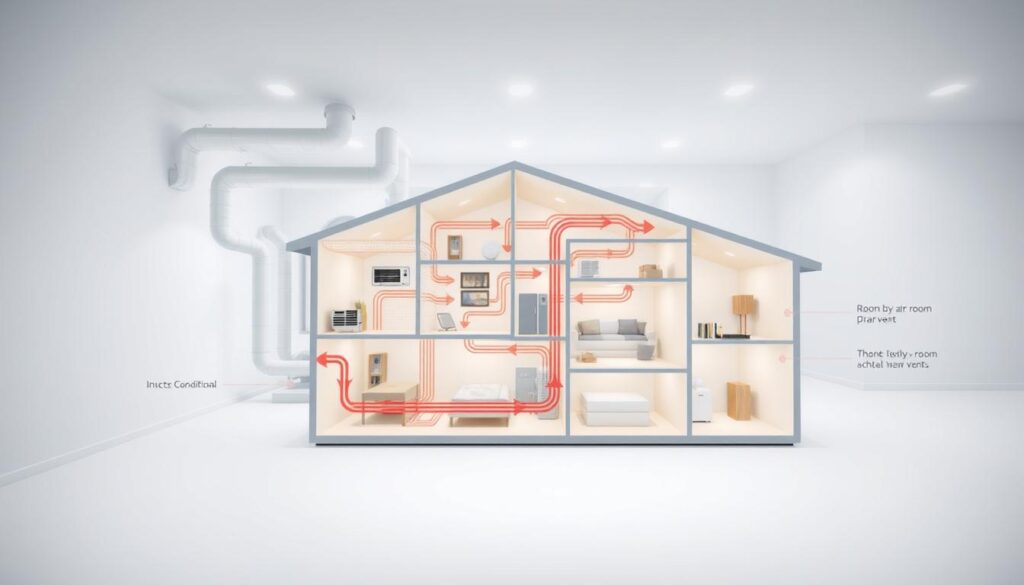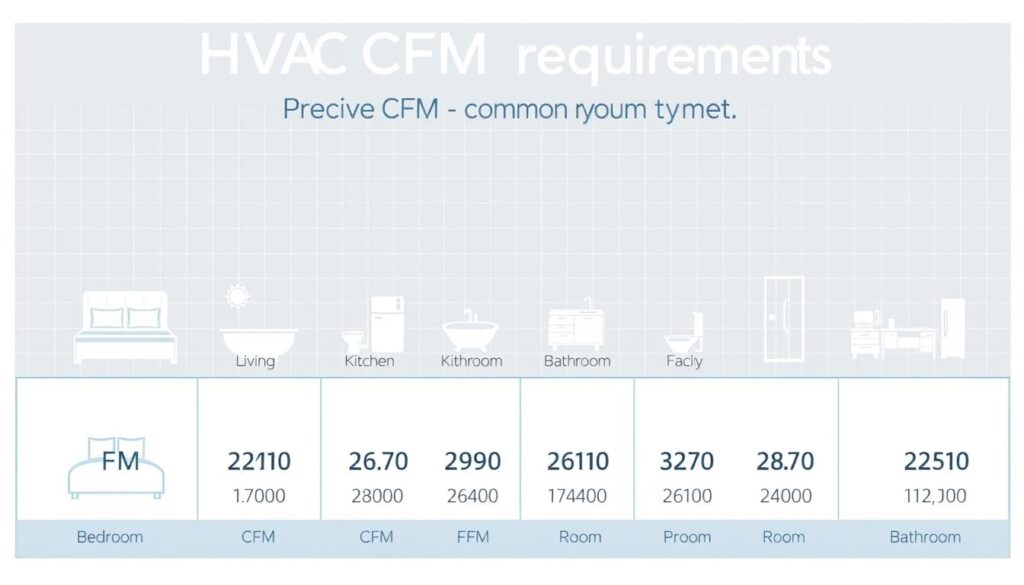Affiliate Disclosure
HVAC Guide Guys is a participant in the Amazon Services LLC Associates Program, an affiliate advertising program designed to provide a means for sites to earn advertising fees by advertising and linking to Amazon.
How Many CFM Do I Need HVAC? Ever felt a room is too hot or cold, even with a working HVAC system? The answer is in CFM – Cubic Feet per Minute. It’s a key measure that can change your home’s comfort and save energy.

Many homeowners don’t think about CFM when choosing an HVAC system. CFM shows how much air your system moves each minute. It affects your comfort and air quality inside.
An HVAC CFM calculator can figure out the air flow your space needs. Knowing this ensures your system works well. It stops hot and cold spots and saves energy.
CFM is more than just numbers. It’s about making your home comfortable and healthy. Learning about CFM helps you choose the right ventilation and temperature control for your home.
Key Takeaways
- CFM measures air volume moving through HVAC systems per minute
- Proper CFM ensures optimal home comfort and energy efficiency
- Professional HVAC technicians use load calculations to determine CFM needs
- Incorrect CFM can lead to temperature inconsistencies
- Regular maintenance helps maintain proper airflow
Table of Contents
Understanding CFM in HVAC Systems
CFM (Cubic Feet per Minute) is key for your HVAC system’s performance. It measures air volume in your home. This affects air quality and system efficiency.
Indoor air can be very polluted, up to five times more than outside air. Good airflow is vital for your home’s health and comfort. The right CFM ensures your home gets enough air and temperature control.
What is CFM and Why It Matters
CFM shows how much air your HVAC system moves per minute. A common rule is 1 CFM per square foot of area. This means the CFM needed changes based on room size and needs.
- Basic CFM calculation: 1 CFM per square foot
- Factors affecting CFM requirements:
- Room size
- Number of occupants
- Heat-generating appliances
- Intended space use
The Role of CFM in Indoor Air Quality
Good airflow is essential for a healthy home. Low CFM can trap pollutants and allergens, causing health issues and discomfort.
Impact on HVAC System Performance
Your HVAC system’s efficiency relies on correct CFM measurements. Too little CFM can cause uneven temperatures. Too much can waste energy. Regular checks and professional assessments help your system work better.
ENERGY STAR recommends maintaining duct leakage at 10% or less to ensure optimal airflow and energy efficiency.
Explore Our HVAC Shop
Looking for top-rated HVAC tools, parts, and accessories? Visit our shop and find the perfect solution for your needs.
Visit the ShopThe Basic CFM Formula for HVAC Calculations
Knowing how to calculate HVAC airflow is key for good indoor air. The CFM per room size uses a simple formula. It helps figure out the air movement needed for your space.
The basic CFM formula is: CFM = (Room Volume in cubic feet) x (ACH) / 60. To use this formula, follow these steps:
- Measure your room’s length, width, and ceiling height
- Calculate the total room volume by multiplying these dimensions
- Determine the right Air Changes per Hour (ACH) for your room type
- Use the CFM formula to find the airflow needed
Let’s look at a living room example for cfm per room size:
| Room Dimension | Measurement |
|---|---|
| Length | 12 feet |
| Width | 14 feet |
| Ceiling Height | 10 feet |
| Room Volume | 1,680 cubic feet |
| Recommended ACH | 6-8 |
With an ACH of 6, the CFM is calculated as follows: 1,680 x 6 = 10,080, then divide by 60. This gives you 168 CFM. It ensures good air circulation and healthy indoor air.
Pro tip: Always check with HVAC experts for your specific room needs. Things like room use, people in it, and local weather can change airflow needs.
Explore Our HVAC Shop
Looking for top-rated HVAC tools, parts, and accessories? Visit our shop and find the perfect solution for your needs.
Visit the ShopAir Changes Per Hour (ACH) and Their Importance
Knowing about Air Changes Per Hour (ACH) is key for good indoor air in homes. ACH shows how often a room’s air is fully replaced in one hour. This affects your home’s air flow and comfort.
Recommended ACH Rates by Room Type
Each room needs a different amount of air flow. Here’s what’s suggested for different spaces:
- Bedrooms: 5-6 ACH
- Living Areas: 6-8 ACH
- Kitchens: 7-8 ACH
- Bathrooms: 6-7 ACH
- Laundry Rooms: 8-9 ACH
Factors Affecting ACH Requirements
Several things can change how much air flow a room needs:
- How many people are in the room
- How active the room is
- Presence of pollutants
- Humidity levels
- Quality of outdoor air
Impact of Building Construction on ACH
Your home’s build affects air flow. New, tight homes might need fans to get enough air. Good insulation and ventilation help your HVAC work better.
| Construction Type | ACH Impact |
|---|---|
| Older Homes | Naturally Higher ACH (More Air Leakage) |
| Modern Tight Homes | Lower Natural ACH, Needs Mechanical Ventilation |
| Well-Insulated Homes | Controlled ACH with Right HVAC Design |
Keeping the right ACH is vital for healthy indoor air and efficient HVAC systems.
Explore Our HVAC Shop
Looking for top-rated HVAC tools, parts, and accessories? Visit our shop and find the perfect solution for your needs.
Visit the ShopHow Many CFM Do I Need HVAC: Room-by-Room Guide

Knowing the right CFM for each room is key for a good hvac system airflow guide. Spaces vary in size, function, and how many people use them. This affects how much air they need.
CFM needs depend on several factors. Here’s a detailed look at what different spaces require:
- Living Rooms: Usually need 3-4 air changes per hour (ACH)
- Bedrooms: Best with 5-6 ACH for comfort
- Kitchens: Need more air at 7-8 ACH because of cooking
- Bathrooms: Require 7-8 ACH to handle moisture and smells
- Laundry Rooms: Highest need at 8-9 ACH
Experts say to figure out CFM needs by looking at room size, ceiling height, and use. The American Society of Heating, Refrigerating, and Air-Conditioning Engineers suggest at least 15 CFM per person. They also recommend at least 0.35 air changes per hour of outdoor air.
To get exact CFM, multiply room square footage by ceiling height. Then divide by 60. Remember, spaces like kitchens and bathrooms might need more air.
Step-by-Step Guide to Calculate Room CFM
Learning to calculate cubic feet per minute (CFM) is key for good indoor air and HVAC system work. It makes sure your rooms get enough air and stay at the right temperature.
To use an hvac cfm calculator right, you need to follow a few steps. These steps look at different things that affect how much air you need.
Measuring Room Dimensions Accurately
Getting precise with CFM calculations is important. Here’s how to measure your room:
- Measure room length from wall to wall
- Measure room width precisely
- Measure ceiling height carefully
- Record measurements in feet
Applying the CFM Formula
The formula to figure out CFM is: CFM = Room Area (sq. ft.) x Ceiling Height (ft.) x ACH / 60. This formula shows how much air you need for good air flow.
Special Condition Adjustments
Some rooms need special CFM thoughts:
| Room Type | CFM Adjustment Factor |
|---|---|
| High Ceilings | Increase CFM by 15-25% |
| Rooms with Large Windows | Add 10% to base CFM |
| Kitchen Spaces | Multiply standard CFM by 1.5 |
For tricky calculations, always talk to an HVAC expert. They can make sure your system works well and saves energy.
Explore Our HVAC Shop
Looking for top-rated HVAC tools, parts, and accessories? Visit our shop and find the perfect solution for your needs.
Visit the ShopCommon CFM Requirements for Different Room Types

Knowing how much air your home needs is key to feeling comfortable. Each room has its own air flow needs. These depend on the room’s size, purpose, and how often it’s used.
Several things affect the air flow needed in each room. The room’s size, how high the ceiling is, and what it’s used for all play a role. They all help determine the air flow needed for comfort and clean air.
| Room Type | Typical CFM Range | ACH Recommendation |
|---|---|---|
| Living Room | 200-400 CFM | 5-7 Air Changes |
| Kitchen | 350-500 CFM | 10-12 Air Changes |
| Bedroom | 150-250 CFM | 3-5 Air Changes |
| Bathroom | 50-100 CFM | 8-10 Air Changes |
A room usually needs about 150 cfm of supply airflow to feel just right. But, most rooms only get about 33% of what they need. This can really affect your home’s temperature and air quality.
- Living spaces need consistent airflow for comfort
- Kitchen requires higher CFM due to heat and cooking activities
- Bedrooms need lower CFM for quiet and consistent temperature
By knowing these air flow needs, you can make sure your HVAC system works well. It will keep the air moving evenly in your home.
Signs of Improper CFM in Your HVAC System
Knowing your HVAC system’s airflow health is key for comfort and efficiency. Your hvac system airflow guide shows CFM’s vital role in system performance.
Spotting signs of bad airflow can stop big problems before they start. To fix this, you need to watch for several important signs.
Symptoms of Low Airflow
- Uneven room temperatures with hot and cold spots
- Weak air from vents
- Higher energy bills from an inefficient system
- Strange noises from the HVAC
- Humidity problems in your home
Indicators of Excessive CFM
- Fast temperature changes
- Short HVAC unit cycles
- More noise when it’s on
- Wear and tear on parts
- Big changes in humidity
When to Consult a Professional
Some signs need a pro right away. If airflow issues keep happening, get a certified HVAC tech to check it out. Look out for these red flags:
- Rooms with different temperatures
- Big energy bill increases
- Ice on evaporator coils
- Constant system cycling
- Strange sounds or smells
Regular upkeep can avoid most airflow problems. Experts say check your system yearly and change air filters every 3-4 months. This keeps your system running well and air clean.
Tips for Maintaining Proper CFM Levels
Keeping your HVAC system’s CFM (cubic feet per minute) at the right level is key. Proper sizing of your ducts is essential for comfort and saving energy. Regular upkeep is vital to keep your system’s airflow strong and avoid problems.
Changing your air filters every three months is a must. Dirty filters cut down airflow, making your HVAC work harder and costing more to run. If you live in a dusty area, you might need to change filters even more often.
Getting your HVAC checked by a pro is also important. They can spot airflow issues and make sure your ducts are right. This can save you up to 15% on energy bills and make your system last longer.
Also, make sure nothing blocks your vents and registers. Stuff like furniture or curtains can mess with your system’s airflow. By following these easy steps, you’ll keep your air quality high, temperatures steady, and your HVAC running smoothly all year.

